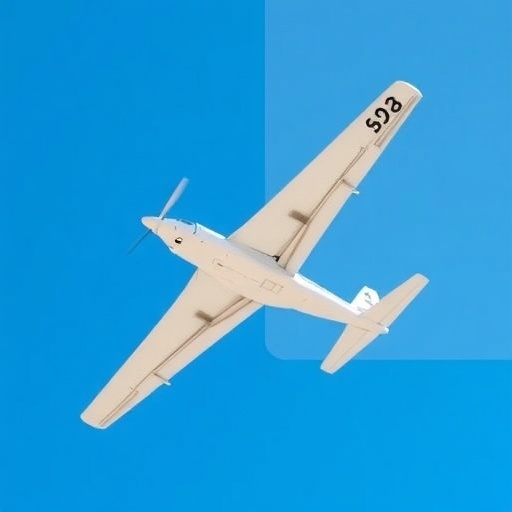In a groundbreaking development at the intersection of aviation safety and next-generation telecommunications, researchers from the King Abdullah University of Science and Technology (KAUST) have unveiled a novel mathematical framework designed to mitigate the interference risks posed by 5G networks to critical aircraft systems. This pioneering study, published in the prestigious IEEE Transactions on Wireless Communications, addresses the urgent problem of spectrum overlap between 5G cellular bands and aircraft radio altimeters, illuminating a path towards safer skies alongside the accelerated data transmission promised by 5G technology.
The crux of the matter lies in the radio altimeter—a sophisticated sensor integral to an aircraft’s navigation systems. These altimeters measure an aircraft’s precise altitude above ground level by emitting and receiving radio frequency waves, delivering data essential for safe takeoffs, landings, and low-altitude flight operations, especially under poor visibility conditions. However, the advent of 5G wireless technology, which operates using exceptionally wide frequency bandwidths to facilitate rapid data exchanges, has introduced unwanted interference that threatens the fidelity of these altimeter signals. Ensuring uninterrupted altimeter function is paramount, as even minor disruptions can compromise flight safety.
What sets this study apart is its innovative application of stochastic geometry, a mathematical discipline traditionally employed to characterize spatially random phenomena, notably in wireless network modeling. For the first time, KAUST researchers have harnessed this approach to analyze the complex spatial interactions between 5G base stations and aircraft radio altimeters, enabling the prediction of interference patterns with unprecedented precision. By treating 5G network elements as statistically distributed entities, the team could simulate real-world deployments and assess how signal overlap manifests in diverse spatial configurations.
The result? A sophisticated design of “exclusion zones” around airports and flight paths, where 5G transmitters limit their emissions to lower-frequency bands to protect altimeter signals from detrimental interference. These zones are not arbitrary buffers but are mathematically optimized areas that reconcile the competing demands of aviation safety and the high-performance needs of 5G networks. Notably, this study reveals that a triangular-shaped exclusion zone surrounding runways offers the best compromise, preserving essential altimeter functionality while minimizing the impact on network service.
The implications of this finding are profound. Inside these protected areas, 5G towers operate using existing lower-frequency spectra, which while less capable of delivering ultra-high data rates, prevent the radio altimeter signals from being overwhelmed. Outside the zones, 5G networks can continue to exploit higher-frequency bands, delivering peak bandwidth performance to consumers. This innovative compromise is akin to closing one lane on a highway—traffic continues to flow, albeit at a reduced pace, balancing safety and connectivity.
The team’s simulations further quantify the trade-offs involved. Even a single 5G tower operating within the exclusion zone can decrease network performance by approximately 20%, while three towers may result in performance drops approaching 50%. Such insights underscore the necessity of carefully planned zone geometries, as overly conservative or poorly shaped exclusion zones could unnecessarily restrict network efficiency, while lax protections risk jeopardizing flight safety.
This research also addresses the real-world disruptions already witnessed since the worldwide rollout of 5G, which has contributed to flight delays and cancellations across multiple countries. Aviation regulators have responded by imposing restrictions on 5G deployments near airports, but until now, guidelines lacked a rigorous research foundation to optimize these limits. The KAUST study provides critical data to inform international policy, facilitating evidence-based decision-making to harmonize 5G evolution with the exacting demands of air safety.
Furthermore, the study’s interdisciplinary nature highlights the growing need for collaboration between telecommunications engineers, aviation safety experts, and regulatory bodies. It exemplifies how applied mathematics and wireless communications theory can join forces to solve multifaceted technological challenges posed by modern infrastructure. The stochastic geometry framework offers a versatile tool applicable not only here but potentially across other domains where electromagnetic interference and spatial network planning intersect.
Details on the researchers themselves further underscore the study’s caliber. Led by Professor Mohamed-Slim Alouini, a noted figure in wireless communications, with substantial contributions from doctoral researcher Safa Khemiri and former postdoctoral scientist Mustafa Kishk, who is now advancing research as an Assistant Professor at Maynooth University, Ireland, the team combines a depth of expertise in both mathematical modeling and wireless systems.
Beyond the immediate focus on radio altimeters and 5G coexistence, this research opens avenues for future investigations into how emerging wireless technologies might harmonize with critical safety systems across transportation and other sectors. Advances in dynamic spectrum management, adaptive power control, and spatially-aware network design could build upon this foundational work to ensure that innovation never compromises safety.
In conclusion, the KAUST-led study marks a seminal stride toward safeguarding aviation operations in the face of the rapid expansion of 5G networks worldwide. By rigorously defining optimal exclusion zone geometries through stochastic geometry, the research balances the imperatives of maximizing 5G’s promise with the uncompromising standards required for flight safety. As regulators and telecommunications operators worldwide grapple with these issues, this work provides timely and actionable insights, helping to chart a course where technological progress and human safety ascend together.
Subject of Research: Not applicable
Article Title: Coexistence of Radio Altimeters and 5G Networks: Modeling, Analysis, and Design
News Publication Date: 8-Aug-2025
Web References: 10.1109/TWC.2025.3594731
Keywords: Applied mathematics, Air traffic




